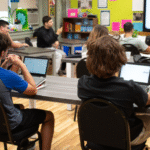Engaging students in the classroom is crucial for effective learning. When students are actively involved, they absorb material better, retain information longer, and develop critical thinking skills. However, keeping students interested and motivated can be challenging. Below are the top 10 strategies to improve student engagement in the classroom, designed to foster participation, enthusiasm, and academic success.
Understanding Student Engagement: Why It Matters
Student engagement refers to the level of interest, curiosity, and involvement a student shows towards learning. Engaged students perform better academically, develop social skills, and build lifelong learning habits. Engagement involves behavioral, emotional, and cognitive participation.
Strategy 1: Incorporate Active Learning Techniques
Active learning shifts students from passive listeners to active participants. Activities like group discussions, problem-solving, debates, and hands-on projects encourage critical thinking and make lessons memorable. For example, the think-pair-share method invites students to think individually, discuss with a partner, then share with the class.
See also: The Future of Education: How Technology is Changing Learning Forever
Strategy 2: Use Technology to Enhance Interaction
Technology can transform lessons into interactive experiences. Tools such as interactive whiteboards, educational apps, and online quizzes engage students and provide instant feedback. Popular tools include Kahoot!, Quizlet, Padlet, and Google Classroom.
Strategy 3: Create a Collaborative Learning Environment
Collaboration helps students learn from peers, develop communication skills, and stay engaged. Group projects, peer reviews, and cooperative tasks promote social learning. Assigning specific roles within groups ensures balanced participation.
Strategy 4: Personalize Learning Experiences
Recognizing that every student learns differently is key to engagement. Tailoring lessons to diverse learning styles, interests, and abilities makes content more relevant. For example, offering project options related to students’ hobbies or future goals increases motivation.
Strategy 5: Establish Clear Expectations and Goals
Clear learning objectives and classroom rules create a structured environment where students understand expectations. Sharing goals at the start of lessons and revisiting them helps students focus and track progress.
Strategy 6: Incorporate Gamification Elements
Gamification uses game principles like scoring, competition, and rewards to motivate students. This taps into their natural desire for achievement. Examples include awarding badges or displaying leaderboards to celebrate progress.
Strategy 7: Encourage Student Choice and Voice
Empowering students by letting them influence what and how they learn fosters ownership. Allowing choices, such as topic selection or project format (video, essay, presentation), increases engagement and creativity.
Strategy 8: Use Formative Assessments Effectively
Low-stakes, frequent assessments like quizzes, exit tickets, or reflections keep students engaged and informed about their learning. These assessments help identify knowledge gaps early, allowing timely instructional adjustments.
Strategy 9: Build Strong Teacher-Student Relationships
Positive relationships boost student motivation and willingness to participate. Showing genuine interest, active listening, and regular encouragement help build trust. Consider one-on-one check-ins or office hours to connect personally.
Strategy 10: Promote a Growth Mindset Culture
Encouraging students to view challenges as opportunities enhances persistence and engagement. Praising effort over innate ability and teaching that mistakes are part of learning fosters resilience.
Additional Tips to Sustain Engagement
- Vary instructional methods to keep lessons fresh.
- Connect lessons to real-world applications.
- Maintain an enthusiastic, positive classroom atmosphere.
- Provide timely, constructive feedback.
Challenges and Solutions in Student Engagement
Common Challenges: distractions from technology misuse, diverse learning needs, low motivation due to external factors.
Solutions: set digital usage policies, differentiate instruction, integrate social-emotional learning support.
Measuring the Success of Engagement Strategies
Monitor attendance, participation rates, student feedback, academic performance, and classroom dynamics to assess engagement improvements.
Conclusion
Enhancing student engagement requires creativity and dedication. By applying these strategies, educators can create vibrant classrooms where students actively participate and succeed. Engagement builds a lasting connection to learning that benefits students throughout their lives.
Frequently Asked Questions (FAQs)
Q1: What is the most effective strategy to improve student engagement?
A: Combining multiple strategies tailored to your classroom works best. Active learning and strong teacher-student relationships are essential.
Q2: How can technology be used without causing distractions?
A: Establish clear guidelines and use technology purposefully to enhance lessons rather than distract.
Q3: How do I engage shy or reluctant students?
A: Use small group or pair activities to build confidence and create a supportive environment.
Q4: Can gamification work in all subjects?
A: Yes, gamification can be adapted to any subject by designing relevant challenges and rewards.
Q5: How can I measure if student engagement is improving?
A: Track participation, gather feedback, and observe academic and behavioral changes.
If you want your classroom to buzz with excitement and meaningful learning, start applying these proven strategies today!




 The Role of Emotional Intelligence in Modern Education
The Role of Emotional Intelligence in Modern Education